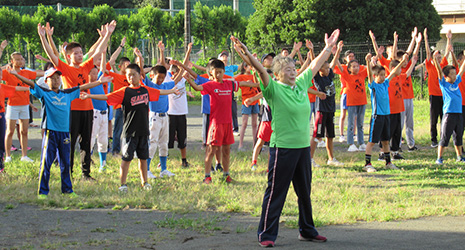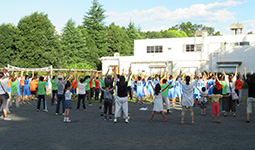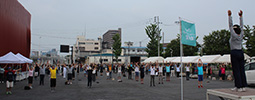Home > Highlighting JAPAN > Highlighting Japan October 2019 > THE SPORTING LIFE
Highlighting JAPAN


Rajio Taiso: Japan’s National Exercises
Radio-taiso gymnastic exercises have long played a role in health promotion in Japan, which is said to enjoy the world’s longest life expectancy. The short exercises have been practiced for more than ninety years by young and old in groups large and small.
Radio-taiso gymnastic exercises are carried out in schools, workplaces and other community gathering spaces. For Japanese people, these exercises are deeply familiar. Participants carry out thirteen types of exercises in about three minutes to recorded light piano music.
Radio-taiso gymnastic exercises are said to have been initiated in the 1920s, when an employee of what is now Japan Post Insurance Co., Ltd. proposed a Japanese version of health exercises that were broadcast by radio in the United States, says Toshihiko Aoyama, president of the NPO Zenkoku-Rajiotaisou-Renmei (Japan Radio-Taiso Federation).
In 1927, the then postal life insurance bureau in the Ministry of Posts and Telecommunications, in cooperation with Japan Broadcasting Corporation (NHK) and what is now the Ministry of Education, Culture, Sports, Science and Technology, created national health exercises to promote the health of Japanese people on the radio. The exercises started to be broadcast in the following year.
The exercises were officially called kokumin hoken taiso (national health exercises) at the time, and the term rajio taiso (radio-taiso gymnastic exercises) was just a nickname. It was the early period of radio broadcasting and radio itself was uncommon, so when the music for the radio-taiso gymnastic exercises came out of the speaker, it attracted a lot of people, says Aoyama.
To disseminate the radio-taiso gymnastic exercises, post office workers across the country provided a pamphlet with illustrations of the choreography of the exercises and held a training session in each area. With the widespread adoption of radio, the exercises gradually became familiar. By 1938, ten years after the start of the radio broadcast of the exercises, as many as 157 million people participated in the radio-taiso gymnastic exercises in Japan each year.
When World War II ended in 1945, however, the General Headquarters of the Allied Forces (GHQ), which was implementing the occupation policy for Japan, prohibited the exercises for some time. They considered the exercises, which were practiced in groups to music broadcast nationally, to be totalitarian. Radio-taiso gymnastic exercises with slower tunes and free moves were subsequently created, but they failed to become established and their broadcast was suspended. However, since many Japanese people told the government and NHK that they hoped that the radio-taiso gymnastic exercises would start again, new exercises that could be practiced regardless of age or gender were created, and their broadcast commenced in 1951.
The new radio-taiso gymnastic exercises were disseminated nationwide in no time. One of the reasons for this was that practices were conducted on school grounds or in parks during elementary school summer holidays. Free attendance cards were provided to students through the schools, and the cards were stamped when a student participated in the radio-taiso gymnastic exercises in the early morning.
Aoyama says that students received a pencil or a notebook at the end of the summer holidays, depending on the number of times they participated, and those with perfect attendance received a commemorative item. As a result, the students competed against one another in terms of participation. At one time, as many as 30 million copies of the attendance cards were printed, which had a substantial impact on the spread of the exercises.
According to a recent survey, it is estimated that about 27 million people still practice radio-taiso gymnastic exercises twice or more a week in Japan. The results of a survey show that those who continue to carry out the exercises have a higher metabolic rate than those who do not, and among elderly people, their body’s internal age is about twenty years younger than their actual age.
In the 1920s, when the radio-taiso gymnastic exercises were initiated, the average lifetime of Japanese people was some forty years, but it now exceeds eighty years both for men and women. From the standpoint of health promotion, there are many requests from overseas to learn the exercises, and Zenkoku-Rajiotaisou-Renmei sends employees to carry out training sessions.
Aoyama says that few attendance cards are delivered to schools these days, and that radio-taiso gymnastic exercises are taught less frequently in physical education classes than they were in the past. Instead the management of radio-taiso gymnastic exercises is typically conducted by neighborhood associations, local retailer associations or local companies, and a wider range of age groups now participate. Radio-taiso gymnastic exercises continue to be loved by people in Japan, not only for their health benefits, but also as an activity that brings people together.
© 2009 Cabinet Office, Government of Japan








